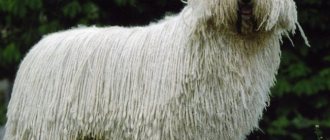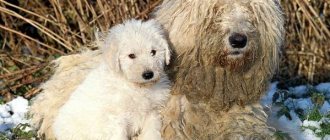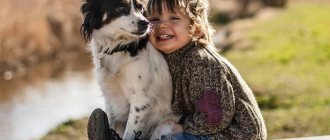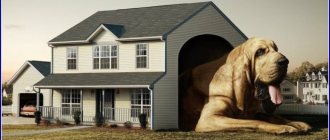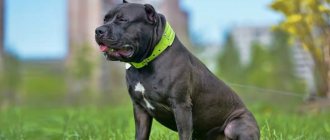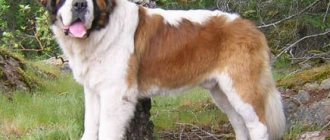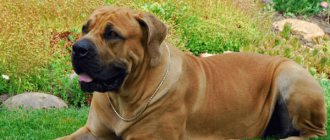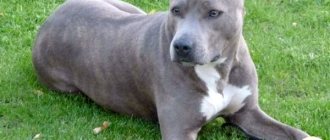History of the Mexican Hairless Dog
The history of the breed began more than 3 thousand years ago, which is why dogs are considered one of the oldest companions of humans. Sculptural figurines depicting dogs were discovered in Central America in the settlements of the Mayan civilization. And the breed itself was registered in 1960 and classified as primitive.
The Xolo dog has an original appearance
What is the name of the breed
The Hairless Dog is also known as the Xoloitzcuintle or Mexican Hairless Dog. The name, difficult to pronounce, has Indian roots and refers to the name of the most ancient deity, the mysterious Sholotl, the patron saint of death and thunderstorms.
Scottish greyhound
This breed arose as a result of the evolutionary process of creating new breeds of animals. Nowadays, a hairless dog of this type is extremely rare. The animal has a gene called the “baldness gene.” It is born with hair and only a month later complete baldness occurs. The hairless dog has lost its exceptional importance due to the fact that hunting is not popular in Scotland.
Features of the Scottish Hairless Dog:
- delicate and sensitive skin;
- It is recommended to use overalls while walking due to the high likelihood of damaging the skin;
- The dog is weak by nature.
Manchurian Hairless Dog
A unique breed that is almost never found even on the territory of its deposit. Residents of the Chinese industrial region of Manchuria call it “tai-tai.” This is a hairless dog with a tuft, which is a type of Chinese hairless dog. Experts in the field of cynology reject this dog as an independent breed. This is due to the fact that there are very few purebreds left.
Features of the Manchurian Hairless Dog:
- animal for allergy sufferers;
- positive and kind, loves to play with the owner and the rest of the family;
- not characterized by the smell inherent in other dogs;
- not susceptible to the appearance of blood-sucking representatives (for example, fleas);
Interesting facts about the Xoloitzcuintle
Karelian Bear Dog: description of the breed
The Xoloitzcuintle is a dog breed that has not only an outstanding appearance and a long history, but also an unusual character. This is a kind, but independent animal, adoring its owner, but treating him in a peculiar, possessive way. The dog sincerely believes that he is not a “pet,” but rather that a person is his property. Very vulnerable, will not survive separation from the owner. If you give it away, even for a while, he will perceive it as a betrayal.
Note! In his homeland, among the Mayan Indians, he was associated with a dark deity and was held in high esteem and even inspired a certain fear.
Xolo is a dog that first appeared in Russia in 1986, arriving from Cuba.
The Xoloitzcuintle is one of the oldest dog breeds in the world.
Ecuadorian naked
The Ecuadorian Hairless breed is considered the most exotic: its purebred representatives are bred by residents of small, remote villages in Ecuador, but they are also found in some European countries. Distinctive features: velvety skin of a soft golden hue, long thin limbs, burdock-shaped wide ears sticking up. Ecuadorians have high intellectual abilities, a keen sense of smell, energy and agility. They quickly become attached to their owner. The average life expectancy is 10-12 years. It is important to consider that these dogs (by nature) are nocturnal, so during the day the pet can sleep for a long time and become active in the late afternoon.
Mexican Hairless Dog - features of the breed
The amazing bare-skinned pet is classified as a Spitz and comes in three varieties: miniature, medium and standard.
Appearance
Bloodhound (hound dog): description of the breed
According to the standard, representatives of the large and medium-sized group can be used as sentinels. Their sizes are respectively: height 45-61 cm and 33-44 cm. The miniature subspecies is exclusively a companion, the height at the withers does not exceed 26-34 cm. The average weight of the dog is 14-16 kg.
Any skin color is acceptable, but plain Xolos are the most valuable. Color options: chocolate, dark, almost black, brownish-yellow, bronze, gray. There is even a tiger shade.
Two varieties of Xolo dog are allowed depending on whether hair is present:
- Completely naked. An additional nuance in the description of this option is an incomplete set of teeth.
- With short fur. There are several scattered tufts of hair on the head, looking in different directions, including a funny crest. At the same time, all the teeth are in place. Also called the Mexican Crested Dog. She looks very interesting.
Durable skin protects the representative of the Xolo dog breed from the adverse effects of external factors: UV rays, insect bites, cuts and abrasions.
Note! The skin is able to protect the xolo well in the conditions of its historical homeland, in sultry Mexico. In Russia, the animal requires mandatory insulation.
Sometimes novice dog breeders may confuse the Xolo with a Chinese Crested Dog or mistake it for a Hairless American Terrier. However, there are differences between the breeds:
- The Chinese dog is larger, its ears, disproportionately large in relation to the body, are decorated with hair.
- Terriers are more strongly built and have a muscular build.
Not everyone will like the original appearance of the Xoloitzcuintle
Characteristics of the Mexican Hairless Dog
The Xoloitzcuintle is a breed with a wonderful character. This is a kind and smart animal, which, of course, is not a leader in obedience (the aboriginal character makes itself felt), but quickly masters the norms of behavior in the owner’s house and tries not to violate them.
This is a very sociable and sociable little dog that does not tolerate prolonged loneliness. Solo-style games are completely unsuitable for xolos.
American Hairless Terrier
Descendants of the Rat Terrier, the American Pied Piper, which arose due to a gene mutation. The hairless puppies that were born caused a wave of disapproval and could have gone unnoticed, but interested enthusiasts decided to create a new breed for people suffering from allergies.
The dogs cannot be called completely hairless: they have a small beard and sideburns. Puppies are born with down, but it completely falls out by 2 months. Animals acquire different colors with all sorts of pigmentation options. Their body is strong and robust, the head is dry and wrinkled with small eyes. But the main advantage of the breed is its large triangular ears.
Such pets are very sensitive and understanding. They love to “talk” with the owner and listen to him. The animals are non-aggressive and treat children and strangers normally. But you should not bring your Terrier into a house where there are guinea pigs or other rodents.
The lack of wool did not affect working qualities. American Hairless remain good rat catchers and are easy to train and train. In addition, they need regular intense physical and mental exercise. The only problem is the need for heat. It is better not to get a hairless dog in cold climates.
The breed is not common in post-Soviet countries, so it is difficult to find purebred puppies. Such a baby will cost no less than 50 thousand rubles.
Features of care
Commander (dog): Hungarian shepherd breed
The Mexican hairless dog is an exotic dog that requires specific care. Bare, hairless skin does not protect the animal well from the harsh Russian frosts, so it is important to think about a warm place in the house before buying a puppy. Be sure to equip a bed - it will protect against drafts and allow the pet to be alone with itself from time to time. Unlike shepherds, this baby is not intended to live outside.
Note! Despite his sociability and devotion, the Xolo values personal space and periodically seeks privacy.
It is important to keep your skin clean. A naked dog is wiped with a damp cloth; Xoloitzcuintles with fur must be combed out periodically. If the skin is dry, lubricate it with moisturizer.
The walk is carried out only in clothes that are selected taking into account weather conditions. You can wash your pet no more than once every 4-6 months, preferably in the summer; after water treatments, the skin is smeared with oil for children.
Other grooming procedures required for a hairless dog:
- Trimming nails using a special guillotine tool.
- Ear cleaning – once every 7 days.
- Brushing your teeth – once a week. You can buy a dog brush or buy your pet special dental bones.
It is important to teach wearing suits and overalls from puppyhood; “dressing up” an adult dog that is not accustomed to clothes is very problematic.
The Xoloitzcuintle is a sociable dog and will get bored alone
Maintenance, care and nutrition
The Chinese Crested Powder and Hairless dog breed requires careful grooming. It is important to monitor your mouth, especially when teeth change. As a rule, this happens at the age of 4 months. It is important not to miss the moment when the fangs have grown and the baby teeth have not yet begun to fall out. It is necessary to immediately seek help from a veterinarian and have the teeth removed. Primary fangs that have not yet fallen out can negatively affect the bite.
Hairless Chinese Crested Dog puppies need to be monitored for skin condition. In summer, they are treated with special sunscreens. In winter, warm overalls are required. If rudimentary hairs appear, they should be removed immediately using tweezers. Injured areas are treated with antiseptic drugs.
How to make a diet
Representatives of the Xolo breed are prone to allergies, so it is important to approach menu planning for them responsibly. To avoid mistakes, it is better to abandon natural food in favor of ready-made industrial products intended for dogs with allergies. It is important that the composition contains a sufficient amount of protein and does not contain any food coloring or other chemicals.
Note! As your pet ages, his teeth will inevitably begin to crumble and fall out, so he is gradually transferred to soft canned food of at least super-premium class.
If you have some experience in keeping dogs, the use of natural food is allowed; in this case, the diet should consist of 60% protein-rich lean white meat.
It is unacceptable for the following products to get into your Xolo's bowl:
- pork;
- river fish, even boiled;
- sweet;
- white bread, other pastries;
- alcohol;
- smoked and semi-finished products (sausages, stewed meat, canned fish for people).
The exception to sweets is apples. They can be given to enrich with vitamins and clean teeth.
The dog needs round-the-clock access to clean water; it is changed in the bowl at least twice a day.
A properly formulated diet is the key to a dog’s health and longevity.
Diagnostics
First of all, the veterinarian will perform an external examination of the dog and take an anamnesis. Next, the doctor will choose one of the diagnostic methods to detect alopecia in a pet:
- Biopsy;
- Phototrichogram;
- Glow with an ultraviolet lamp;
- Biochemical, mycological and bacteriological studies of skin scrapings;
- General analysis of blood, urine and feces.
Read Blood tests for dogs: types and interpretation of indicators
An ultrasound may be prescribed to examine the functioning of the thyroid gland. The activity of B- and T-lymphocytes in the blood, the content of antigens and protein are being studied.
Genetics and health
Any native breeds have good health and the Xolo is no exception. Dogs that come from Mexico practically do not get sick. However, the intervention of breeders aimed at saving the breed caused the appearance of some diseases characteristic of Xolos. Among them:
- Weak cartilage, externally expressed in drooping ears.
- Pathologies of the skin: the appearance of irritations.
- UV rays can cause skin burns.
- Predisposition to allergies.
- With age, teeth become less strong and begin to crumble.
- Dermatitis.
It is very important to give your Xolo pet all the necessary vaccinations. It is easier to prevent any disease than to cure it. Moreover, the dog may be allergic to medications and anesthesia.
Interesting! Life expectancy is 14-18 years.
Symptoms of alopecia in dogs
Why does a dog howl at night in the yard: reasons
There are different symptoms for each type of dog hair loss. However, the most common symptoms are:
- If the cause is a hormonal imbalance, then the hair on the sides falls out evenly or in patches. In addition, the presence of hyperpigmentation is noted.
- During the next seasonal molting, the hairs fall out evenly, the skin does not remain bald.
- Improper diet and lack of vitamins leads to the fact that the coat becomes thin and very sparse.
- After poor grooming, the coat may not recover for a long time.
- Allergic dermatitis leads to hair loss in chunks, inflammation and redness.
- If the cause is parasites, then there is focal hair loss and the dog scratches the skin vigorously.
- After stress, a dog's fur becomes thin and falls out evenly.
It is almost impossible to determine the form of alopecia by appearance, so in any case you will need to contact a specialist.
In advanced cases, complete baldness of the animal is necessary.
Who is it suitable for?
A “bald” dog, as the Xolo is sometimes unkindly called, is a dog only for those who love animals and are ready to take care of them. A representative of the Mexican breed is categorically not recommended for busy people who are constantly missing at work. A pet needs communication with its owner, without whom it will suffer.
In addition, families with children should choose a different purebred puppy. A tiny hairless dog is not a living toy; careless movement by a child can cause injury.
The Mexican Hairless Dog is suitable for those who are willing to devote time and attention to it.
Xolo is suitable for responsible and serious people who already have experience in keeping dogs. The breed, for all its attractiveness, is distinguished by its disobedience, so the dog needs a strict but fair owner.
It is important to soberly assess your strengths, to understand whether it will be possible to constantly make preventive visits to the veterinarian, buy expensive food and clothing, shoes, and oil for skin care for your pet. If yes, then you can safely head to the nursery.
Chinese Crested
The bald dog breed is the Chinese Crested Dog. By the way, among all hairless dogs, this breed is the most popular. And its popularity is a merit not only of today.
So, for example, these dogs were known in China more than 2 thousand years ago. There, hairless Chinese Crested dogs were treated as sacred animals.
But in Europe and other parts of the world the breed became popular at the end of the 19th century, thanks to the fact that one of these dogs was brought to Great Britain. From there the breed spread to other countries, including America. By the way, these dogs are mainly owned by stars, show business representatives and shocking fans. After all, it is simply impossible to remain in the shadows next to such a dog.
But what do we know about the character of these dogs? It turns out that they have natural sensitivity, flexibility, unobtrusiveness, lack of aggressiveness and quick intelligence. They easily find a common language with other animals and can be adopted by families with children.
The center of the universe for these dogs is their owner, separation from whom is very difficult for them to endure. A dog can even get sick in the absence of the main person in its life. She has a hard time with moving, traveling, and loneliness.
Read about other family dog breeds on our website most-beauty.ru. Here you will also find an article about dogs that you can easily travel with!
If, due to circumstances or the nature of your work, you are rarely at home, it is better to refuse representatives of this breed in your home.
She will not remain silent about the fact that the Chinese Crested does not like loneliness. In this case, your neighbors will complain about the constant howling and barking of the dog when she is alone at home, and you will be faced with her little dirty tricks on every corner. So, think about it, are you ready to have an animal that is mega attached to you, a fountain of energy in dog form?
If the difficulties did not frighten you, and you decided, after looking at the photo and description of the breed, to get just such a pet, you should take into account some nuances. Representatives of this breed are not cheap. But, if you do not plan to participate in exhibitions in the future, breed puppies, and you need a dog for your soul, to save some money, you can purchase a crested puppy without documents.
True, there is a great risk of choosing a mestizo rather than a purebred representative of the breed. When choosing a puppy, be sure to pay attention to the condition of the coat (minimal) and skin and whether the photo of the representative of the breed matches the selected puppy. There should be no rashes, redness, or scratching on the animal’s body.
Hairless dogs are very delicate, so in cold weather the Chinese Crested will need clothing for walking. Fortunately, today in any pet store you can buy not only beautiful, but also warm suits for walking.
As for recommendations regarding feeding, breeders recommend avoiding a mixed type of diet, giving preference to either natural food or ready-made premium food.
Xolo puppies
Buying a Xolo puppy should only be done from reputable breeders. Before you go to pick up your baby, it’s a good idea to read the reviews.
To avoid mistakes, you should pay attention to the following factors:
- Keeping puppies and adult dogs requires a warm, clean room.
- Documents of parents and children themselves must be in perfect order. Breeders must present all papers upon request.
- Xolo puppies are often active and playful. The baby sitting in the corner most likely has health problems and will not live long.
- Pets with uniform skin color are considered the most valuable.
- The appearance is also assessed: narrowed muzzle, ears set and spaced wide, body proportional, fragile, but not painfully thin.
The average cost of representatives of the Xolo breed varies from 10 to 150 thousand rubles*. The most expensive puppies, descending from their historical homeland.
Xolo puppies are the embodiment of grace and spontaneity
Appearance of the Xoloitzcuintli and its character
Completely hairless, delicate skin is the main feature of this breed. Although you can also find downy individuals, which is much less common. A little hair is also acceptable. It is the lack of wool that causes the main characteristics of the breed:
- Their skin is prone to tanning, so light-colored dogs need protection from the sun;
- Xolo has a harmonious physique and a toned torso, long legs and tail, and her chest is well developed.
Another feature of the breed is the unusual structure of its teeth: it does not have 4 teeth following the canines (premolars). This structure is not a defect, it is quite natural, since the gene responsible for the presence of hair is directly related to the gene that determines the presence of certain teeth. Some representatives of the breed lack not only premolars, but also canines.
This is a calm and intelligent dog, capable of listening carefully to its owner. Strangers make her suspicious, so her protective qualities are completely obvious. Overall, this is an excellent companion who will not disturb your privacy, but will not leave you indifferent. Xolo has a calm but cheerful disposition. Her attachment to one person is strong, whom she considers her master. But this dog will not completely ignore other family members.
Additional features: she does not bark, does not tolerate aggression and loneliness.
We advise you to read: Skye Terrier Dog Breed
A Brief Overview of Other Hairless Dog Breeds
In addition to the Xoloitzcuintle dog, there are other, no less interesting breeds that are devoid of hair.
American Hairless Terrier
The history of the breed began in the 1970s in the USA. But it has not yet received full official recognition. The good thing about a dog is that it almost never causes allergies, so it is adopted by those for whom this problem is relevant. Life expectancy is 15-16 years, which is generally not bad for hairless dogs. This is a small but active and dynamic dog. The wedge-shaped head is topped with V-shaped ears. The tail is mobile, saber-shaped.
He takes training well, is able to get along with other pets, and is loyal to cats.
The second well-known name of the breed is the American Hairless Terrier. The first such dog was born in 1972 from rat-catching terriers. The owner became interested in the lack of fur, and he began to identify and fix the gene responsible for it. To this day, the breed is considered rare.
Chinese Hairless Crested Dog
This is another crumb of the canine world - average weight - up to 5 kg, height - about 30 cm. The completely hairless body contrasts with the ears, decorated with long thick fur and limbs, also covered with hair. Long soft hair is also present on the tail.
The Chinese Crested Dog is an unusual and attractive pet.
Like Xolos, they can hardly tolerate loneliness, so busy people and those who periodically go on business trips should look for a different breed.
Note! These are incredibly smart animals that do their best to please their owner. They will conscientiously study any commands in order to earn the praise of their owner.
Manchurian Hairless Dog
Very similar to the Chinese corydalis, but almost completely devoid of hair. There is only a small bang. It has a slender build and thin pink skin. The average weight of such a dog is 7 kg, height at the withers is 24-32 cm. A kind and devoted dog will adore its owner, and perceive separation from him as punishment.
There is also an African Hairless Dog, very similar in appearance to its Manchurian relative. But this terrier is twice as large (weight up to 15 kg), cannot bark at all, only makes whining sounds when feeling pain or grief. Skin color is dark, close to black.
Note! The African Hairless Terrier is a wayward dog, the most complex in character among the hairless ones, it is difficult to train and requires a responsible approach.
Description
Peruvian hairless dogs are similar in appearance to Mexican dogs, sometimes even dog handlers confuse them.
Mexican and Peruvian hairless dog.
Here are 6 subtle anatomical differences:
- Peruvians look more graceful and slender.
- The body is less elongated.
- The belly is lean, more toned.
- The line of the back is slightly convex in the lumbar region; in Mexican dogs it is always flat.
- The ears are set wider apart.
- The transition from the forehead to the bridge of the nose is more pronounced.
Peruvian litters produce puppies that are hairless and covered with close-fitting short hair. Hairless individuals have erect ears, while woolly ones sometimes fall down under the weight of hair.
There have been cases where puppies were born with hair, but during the first molt it fell out and did not grow back. Hairless Peruvians sometimes have tufts of hair on the top of their heads, tails, and paws.
Peruvian hairless dog puppy.
Among Peruvians there are also 3 dimensional types:
- Small – height 25 – 40 cm, weight 4 – 8 kg.
- Medium - height 41 - 50 cm, body weight 9 - 12 kg.
- Large ones - height 51 - 65 cm, weight 13 - 30 kg.
The color develops gradually. Puppies are born black or pink, then contrasting spots appear. The markings grow, merge and form the final color.
Peruvian dogs live 12 – 15 years, they have good health. In some lines, a tendency to inflammation of the pancreas and epilepsy is inherited. Light-colored animals quickly get sunburned and are predisposed to skin cancer.
Character of Peruvian Hairless
Peruvian Inca orchids adapt to any lifestyle and lifestyle of the owner and become real members of the family. They treat their family with tenderness and expect attention and approval in return. They do not run away during walks and always keep their owner in sight.
Peruvian hairless dog.
Inca orchids love the company of children. They make vigilant watchmen. Dogs do not trust strangers and do not tolerate the touch of others. They treat other animals with restraint and do not enter into conflicts. They can chase other people’s cats on the street, but they don’t touch “their own” cats at home. Peruvian dogs are easy to train, but do not tolerate rough handling.
History of the origin of the breed
The time of appearance of the Inca hairless dog is rather vague, from the 3rd century BC. until the 14th century AD Artifacts depicting similar animals found during archaeological excavations, rock paintings and ancient frescoes date back to precisely these time periods. This means that they existed even before the appearance of the Incas.
Opinions also differ about how dogs got into Peruvian territory. Some argue that the dogs were brought in by the Chinese during immigration. According to others, this happened thanks to Asian settlers who arrived in America through the Bering Strait. There are also those who attribute African origin to the breed.
The Incas considered these unusual creatures to be sacred animals and helpers of the gods, along with five other breeds of dogs. They were worshiped and various rituals were performed with their participation. One of the names of the breed is “Peruvian Moon Dog”. Since the 16th century, with the advent of the conquistadors, hairless dogs could only be found in rural areas. There they were crossed with local furry dogs.
It was only in the 19th century that the Peruvian authorities decided to take custody of the endangered breed. From this time the official history of the Peruvian Inca orchid begins. It took almost a hundred years to restore the breed. In 1981 it was recognized by the International Federation of Cynologists. The final standard was approved in 1994. And since 2001, the once sacred dogs have become the country's national treasure. Unfortunately, the breed is not widespread and is considered rare even in its homeland.
